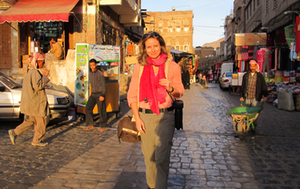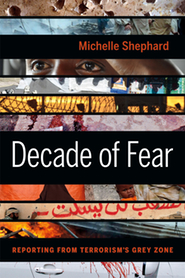Join Michelle Shephard for a conversation with Bart Gellman about A Decade of Fear at Princeton University’s Woodrow Wilson School of Public and International Affairs, in Robertson Hall, on Tuesday, October 11, at 4:30 p.m.
Michelle Shephard of the Toronto Star was on top of the “war on terror” story before that name had been coined, covering it even in its most dangerous corners — places like Mogadishu and Sanaa — and demonstrating a fearlessness and tenacity that few national-security reporters can match. In her new book, A Decade of Fear: Reporting from Terrorism’s Grey Zone, Shephard displays deep insight and an irrepressible sense of humor as she moves through the high and low points of America’s transformation in the decade after 9/11. I put six questions to Shephard about her book.
1. I had been hearing for some time that former CIA director Porter Goss liked to demonstrate waterboarding using bar nuts — then I picked up your book and read a firsthand account of him doing so. What did you learn from your cruise with Goss and his successor, Michael Hayden, about the mentality of the men who ran the agency during the Bush years?

Those interviews, conducted aboard a “Spy Cruise” last fall, were among the many rather surreal moments I’ve had the past ten years, but they did provide me with some unguarded comments (using some interesting props). Both men were resolute in their support of disputed “enhanced interrogation techniques,” which they claimed produced results, and they objected to Obama’s use of the word “torture” to describe waterboarding. Hayden emphasized that he understood the debate, but he didn’t subscribe to the view that the methods produced unreliable intelligence, as others have testified — or that they provided Al Qaeda with a propaganda gift. Goss said he was tired of the media scrutiny and second-guessing.
Hamid Gul told me he admired the Pakistani-based Haqqani group and its leader. “When the United Nations Security Council tried to put me on the list, I categorically said, ‘I respect Haqqani. He is a great mujahid. He is an honourable man, so are my friends in the Northern Alliance.’ More than half of the governors in Afghanistan are my friends. . . . That doesn’t mean that I have the ability to help them. As you can see, I’m sitting here.”
“As Tony Soprano,” I responded, and a quizzical look came over Gul’s face.
“Tony Soprano?” I tried again, describing the popular American television series and explaining he had been compared to the main character in a Washington Post blog.
“Tony Soprano, what did he do? Is he a villain or a hero?” he asked.
How do you explain a mob boss who runs a strip club and orders hits, but who was painfully human, had panic attacks and cried to his shrink?
“I would say he’s a sympathetic villain.”
Without missing a beat Gul replied, “Ah, or an unsympathetic hero.”
—From Decade of Fear: Reporting from Terrorism’s Grey Zone. Reprinted by permission of Douglas & McIntyre, © 2011 Michelle Shephard.
2. A good deal of your book and your reporting chronicles how Canadians were caught up in the “war on terror” — from stockbroker David Barkway, who was in the 105th floor of the North Tower when the first plane struck on 9/11 and who perished that day, to Maher Arar, the engineer who was sent to and tortured in Syria, to Omar Khadr, the child soldier whose prosecution at Guantánamo was frequently sensationalized in the media. How have these varied experiences affected cooperation between America and Canada in dealing with terrorism?
I think the high-profile cases have strained the relationships between the various agencies simply by putting the spotlight on their activities. In the panic after 9/11, we learned that few caveats were being attached to information-sharing, but that both countries lacked some necessary expertise. A federal inquiry into Arar’s case, for instance, found that our national police force, the Royal Canadian Mounted Police, had provided erroneous information to the United States, which contributed to the decision to render him to Syria. Arar received a multimillion-dollar settlement from Canada as a result. Then there was the revelation that our foreign-affairs department had a training document listing the United States among countries that torture prisoners, which caused much embarrassment in Ottawa. I wondered how that later trickled down. But looking now, ten years after 9/11, the level of expertise has improved, and according to investigators and agents, the partnership between the countries is a model of cooperation. Hard to test that assertion though.
3. Only a handful of Western reporters have spent time on the ground in both Mogadishu and Sanaa, observing groups like Al Shabab and Al Qaeda in the Arab Peninsula (AQAP), and studying American efforts to combat them. The Obama Administration is preparing an aggressive new strategy for Somalia and Yemen that relies heavily on the use of drones. How do you think this tactic will play out?
This is undoubtedly preferable to boots on the ground, which would have disastrous results in both countries. But I do think there are great risks with drone attacks as well, mainly due to what is horribly known as “collateral damage.” For every hit on a well-known target, such as the recent killing of AQAP ideologue Anwar al-Awlaki, there are attacks based on faulty intelligence or near-misses that kill civilians. We have seen this in Pakistan. The Shabab and AQAP do not enjoy widespread support — the Shabab in particular are vulnerable due to the famine, and to backlash among Somalis, who accuse them of blocking food aid. But these groups will use as recruiting tools any drone strikes that kill women or children, as well as the questionable legality of U.S. bombing in countries outside the theater of war. The problems in Somalia and Yemen are complicated, and people are sick of being viewed only through the prism of terrorism. Both countries need political and economic stability and tremendous amounts of humanitarian aid, and until these are achieved, AQAP and Al Shabab will continue to exist. They can’t be killed off member by member.
Nasser al Awalki was well known and connected in Yemen and came from the large, powerful and respected al Awalik tribe, which his grandfather once governed. He was the country’s former agricultural minister and was a Fulbright scholar and friend of the embattled president, among other high-level figures in the government and security service. At first I kept my tape recorder off and notebook shut, since he said he wasn’t interested in talking on the record. But as we discussed how his son had been elevated to “Terrorist Number One,” in the United States he changed his mind and encouraged me to record the interview. “I don’t care anymore,” he said, shaking his head and staring at the dissolving Nescafé coffee crystals. “Do you know now Anwar is very popular in the Muslim world?” he asked me. “The Americans made a big thing of him. One year ago no one knew him in the Arab world, or even in Yemen. But now every Arab knows him.” I could certainly attest to the fact that when I first went looking for him in early 2009, few in Yemen had heard the name Anwar al Awlaki.
—From Decade of Fear: Reporting from Terrorism’s Grey Zone. Reprinted by permission of Douglas & McIntyre, © 2011 Michelle Shephard.
4. The “decade of fear” in your title refers to the ten years of military intervention by the United States in the Middle East, and ends with a series of uprisings from Morocco to Yemen that seem genuinely transformational. What connects these things?
That’s a tough question, and I’m not sure we can answer it yet, as the reverberations of the Arab Spring are ongoing and each country’s situation is unique. Fear in the West drove more than just military intervention — it drove everything from our color-coded warnings to costly security measures at airports. What frightened us was the thought of another 9/11. But the people in the Arab world feared their governing regimes — the ones the West was propping up to combat groups affiliated with, or inspired by, Al Qaeda. The Arab Spring provided a wake-up call to the West about the transformational power of popular movements and about how steps toward democracy can be achieved without military intervention. Again, we have to stop looking at countries exclusively through the prism of terrorism.
5. You were one of four journalists covering the military commissions at Guantánamo who were expelled in May 2010, for daring to mention the name of a soldier with whom you had already published an interview. Why do you think you were booted from Gitmo, and what did you and your paper do about it?
The Pentagon has always tried to shape the news coming out of Guantánamo, from the censorship of photos to Gitmo-gab (suicides as “asymmetric warfare,” “force feeding” of hunger-striking detainees as “enteral feeding,” etc.) I think a public-affairs official in Washington saw this as a way to get rid of us. He argued that we had broken the ground rules for media by identifying a former army interrogator who had been convicted for his role in the death of another detainee. The problem was we hadn’t — and as you mentioned, the interrogator had already waived his right to anonymity by giving me an on-the-record interview two years earlier. As one columnist quipped, we were asked to have amnesia. I don’t think the Pentagon anticipated the backlash. We appealed and hired a lawyer, and thanks to McClatchy (veteran Miami Herald reporter Carol Rosenberg was one of the four expelled journalists), the Pentagon Press Association, and many columns and editorials decrying the ban, we won and were welcomed back. Since Obama hasn’t been able to close the facility, I guess I’ll be gearing up for trip number twenty-four soon.
6. The most touching chapter of your book plays out in a city 200 kilometers north of the Arctic Circle. What brought you to Harstad, Norway, and what did you find there?

That story began in January 2010, when I met seventeen-year-old Somali Ismail Khalif Abdulle in Mogadishu. He had refused to join the Shabab, and they decided to make an example of him by kidnapping him and then amputating his foot and hand in a crowded stadium. When he told me his story and begged me to help, it just broke my heart. But it turned out I wasn’t the only one touched by Ismail’s plight. When his story ran in the Toronto Star, it provoked outrage. Canada’s Somali diaspora — and one man in particular, a former journalist named Sahal Abdulle — decided to save Ismail. Nine months later, I was in Kenya with Sahal when Ismail arrived after a harrowing three-day journey. Norway was the first country to accept him as a refugee. The three of us flew together to Harstad this January. I will never forget when Ismail saw snow for the first time, or as we tried to explain why there were only two hours of twilight in the winter. We keep in touch — he’s a beautiful kid. He’s studying in Norway now and has a great chance for a future. There were three other young men in that stadium with Ismail, and I hope to find them soon, too.



